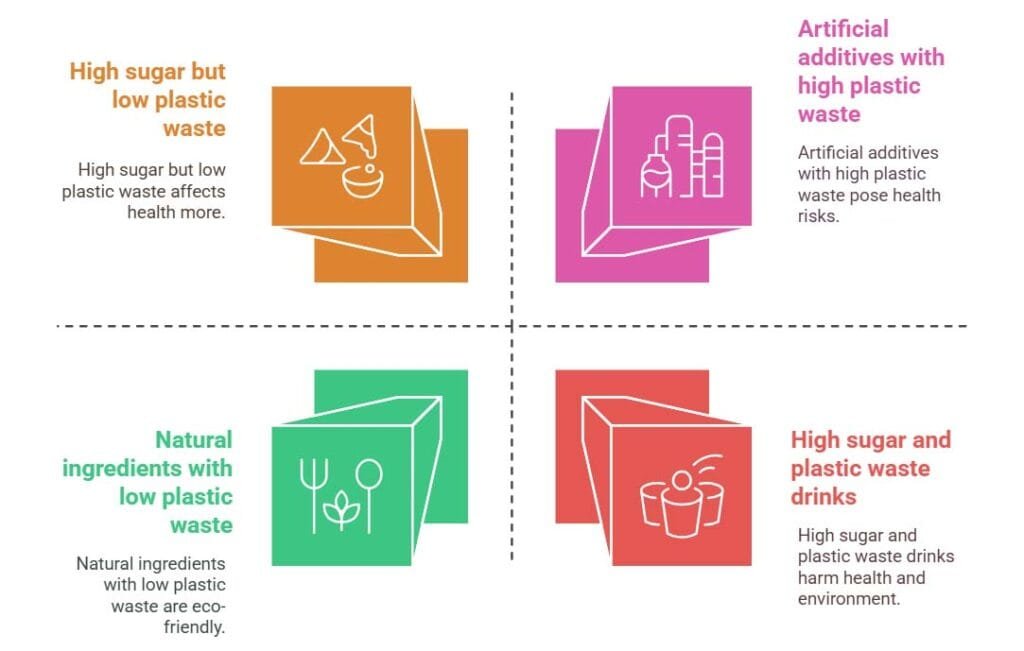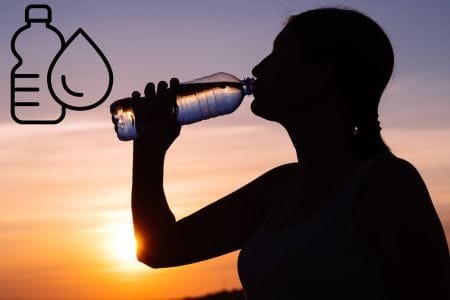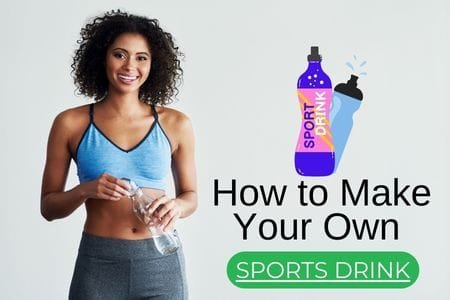Introduction: The Problem with Store-Bought Sports Drinks
Imagine that: You’ve already been put through your paces in a gruelling workout, are soaked in sweat, and are eagerly reaching for your brightly colored energetic drink to satisfy your thirst. But wait, what is the content of that bottle? Beneath the eye-catching advertisements is a compound of high-fructose corn syrup, synthetic dyes like Red 40 (responsible for hyperactivity in children), and preservatives such as sodium benzoate.
The average 20-ounce make your sports drink contains 34 grams of sugar— this means you could potentially consume 8.5 teaspoons at one go, like you are throwing sugar into your mouth. Even those that are “sugar-free” are filled with artificial sweeteners like aspartame, which have been suggested in studies that can lead to gut problems.
Yesterday’s hydration was good, your health remained intact, and you still had enough in your bank account. Avoid this using homemade, make your sports drinks offering a cleaner, more innovative, and custom solution. The better-for-you nectar — the do-it-yourself nature of the drink with hydrating substances— allows the body to operate with energy and the person to stick with his business ethic. The document does not only talk about mixing water and other liquids. It is about taking the reins of the food you eat. Let’s check the scientific part and teach you to make a personal, customized drink that will stay on par with your energy levels.

Why Ditch Commercial Make Your Sports Drinks?
The Dark Side of Popular Hydration Brands
The grocery store aisle is carpeted with as many neon-coloured bottles as the eye can see, all of which promise “rapid rehydration” and “peak performance.” Let’s demystify the gutless boast with these three lines:
- Sugar Overload: A 32-ounce bottle of Gatorade contains 56 grams of sugar—over a 12-ounce Coke. The glycemic index of some sugars is slower or quicker, which is essential for this energy. However, an excess amount of sugar increases insulin levels, making a person have energy crashes and gain weight.
- Artificial Additives: Some drinks are flavoured with brominated vegetable oil (BVO) to prevent them from separating. This substance has been banned in both Europe and Japan after research linked it with health issues such as thyroid disorders and neurological damage.
- Environmental Toll: Over 100 billion plastic bottles are sold globally yearly, with less than 30% recycled. Many are found in landfills or oceans, and this causes microplastics to get into ecosystems.
- Costly Habit: At
- 2–
- 2–4 per bottle, regular users spend $500+ annually to purchase a high-quality blender that can last you for a year or a year’s supply of organic ingredients.
The Homemade Advantage
Developing a make your sports drink isn’t just a do-it-yourself project but also an act of revolt against exploitative marketing and the squandering of resources. This will allow you to manage not only your budget but also to slim down the number of plastics, and to stay away from ingredients you cannot figure out how to pronounce. Besides, you will be able to change the taste or nourishments and also be able to do it in line with your workout intensity, dietary needs, and even the weather.
The Science of Hydration: What Your Body Needs
Electrolytes 101: The Unsung Heroes of Performance
When you sweat, you are not only losing water from your body but also electrolytes that are being lost. Minerals that conduct electricity are the subject of electrolytes, and these are crucial factors in the following processes:

- Nerve Function: They, especially sodium, the most significant mineral, and potassium, the most important, are responsible for sending signals between nerves and muscles.
- Fluid Balance: Magnesium works as a gatekeeper, controlling the correct quantity of water that enters and exits each cell.
- Muscle Contractions: Calcium acts like an on/off switch guiding every step of the contraction and relaxation processes of the muscles.
- pH Balance: Bicarbonate is the substance that can neutralize lactate acid produced during exercise when we neglect carbohydrate food products.
The Key Electrolytes:
- Sodium (Lost most through sweat)
- Potassium (Prevents cramps and fatigue)
- Magnesium (Reduces post-workout soreness)
- Calcium (Supports normal bone development and works in the muscles)
Carbohydrates: The Fuel Your Muscles Crave
When you eat carbs, your body gets the energy it needs for physical activities. Natural sugars (like those in fruit juice or honey) deliver quick glucose to muscles, while complex carbs (e.g., oats) give sustained energy. The ultimate drink for sports manages to marry the two. Protein and carbs are also added after the workout:
- Low-Intensity Workouts: 5–8 grams of carbs per 8 oz.
- High-Intensity/Endurance: 14–18 grams per 8 oz.
Building Your DIY Make Your Sports Drink: Ingredients & Tools
Core Ingredients for Every Recipe

- Fluid Base:
- Filtered water (avoid tap water with chlorine).
- Coconut water (naturally rich in potassium).
- Herbal tea (e.g., hibiscus for antioxidants).
- Electrolyte Sources:
- Sodium: Himalayan pink salt (contains 84 trace minerals) or sea salt.
- Potassium: Coconut water, orange juice, bananas.
- Magnesium: Spinach, almonds, or a pinch of food-grade Epsom salt.
- Calcium: Chia seeds, tahini, figs.
- Natural Sweeteners:
- Raw honey (antibacterial, anti-inflammatory).
- Maple syrup (high in manganese and zinc).
- Medjool dates (fibre-rich and easy to blend).
- Flavor Boosters:
- Citrus zest (lemon, lime, grapefruit).
- Fresh herbs (mint, basil, rosemary).
- Spices (ginger, turmeric, cinnamon).
Tools You’ll Need
- A glass pitcher (plastic can leach chemicals).
- Reusable bottles (stainless steel or BPA-free).
- Fine mesh strainer (for pulp-free drinks).
- Blender (to puree fruits or herbs).

Step-by-Step Recipes for Every Athlete
1. Classic Citrus Electrolyte Drink
Best For: Moderate workouts (45–60 minutes), hot yoga, or outdoor activities.
Ingredients (Makes 1 liter):
- 4 cups filtered water
- 1/4 cup fresh lemon juice (packed with vitamin C)
- 1/4 cup orange juice (natural potassium boost)
- 2–3 tbsp raw honey (adjust to taste)
- 1/4 tsp Himalayan pink salt
- 1/8 tsp baking soda (optional for extra sodium)
Instructions:
- Combine Liquids: Pour water, lemon, and orange juice into a pitcher.
- Add Electrolytes: Whisk in salt and baking soda until dissolved.
- Sweeten: Stir in honey gradually—taste as you go to avoid over-sweetening.
- Chill: Refrigerate for 30 minutes to let flavours meld.
- Serve: Pour into a reusable bottle and sip during exercise.
Pro Tips:
- For a fizzy twist, swap still water with sparkling.
- Freeze into ice cubes and blend post-workout for a slushie.
Nutrition per 8 oz:
- Calories: 35–40
- Sugar: 6–8g (from natural sources)
- Sodium: 150mg
- Potassium: 120mg
2. Tropical Recovery Drink with Coconut Water
Ideal For: Endurance athletes, post-workout recovery, or hot climates.
Ingredients (Makes 1 liter):
- 2 cups coconut water (naturally contains 500mg potassium per cup!)
- 2 cups filtered water
- 1/2 cup mashed pineapple (digestive enzymes + natural sweetness)
- 2 tbsp fresh lime juice
- 1/4 tsp sea salt
- 1 tbsp chia seeds (omega-3s + calcium)
Steps:
- Blend Pineapple: Pulse the pineapple in a blender until smooth.
- Mix Base: Combine coconut, filtered, and salt in a pitcher.
- Add Flavors: Stir in lime juice and chia seeds.
- Incorporate Fruit: Fold in pineapple puree.
- Rest: Let sit for 10 minutes so chia seeds plump up.
Storage: Keeps in the fridge for 3 days—shake well before drinking.
Nutrition per 8 oz:
- Calories: 50–55
- Sugar: 9–10g (from fruit)
- Sodium: 160mg
- Potassium: 400mg
3. Sugar-free Hydration for Keto & Low-Carb Diets
Perfect For: Ketogenic athletes, diabetics, or anyone avoiding sugars.
Ingredients (Makes 1 liter):
- 4 cups herbal tea (cooled) – try peppermint or chamomile
- 1/4 tsp Himalayan salt
- 1/8 tsp cream of tartar (potassium boost)
- 10 drops liquid stevia or monk fruit extract
- 1 tbsp apple cider vinegar (balances pH)
Instructions:
- Brew herbal tea and let cool completely.
- Whisk in salt, cream of tartar, and stevia.
- Add apple cider vinegar and stir.
- Chill and serve over ice.
Flavor Variations:
- Add cucumber slices or muddled basil for freshness.
- Use green tea for a caffeine kick.

Customizing Your Drink: Flavor, Function & Fun
Tailor to Your Workout Intensity
- Low-Intensity (Yoga, Walking):
- Skip added sugars; use infused water with lemon and mint.
- Electrolytes: 1/8 tsp salt + 1/4 cup coconut water.
- High-Intensity (HIIT, Cycling):
- Add 2 tbsp honey or maple syrup for quick energy.
- Electrolytes: 1/4 tsp salt + 1/2 cup orange juice.
- Endurance (Marathons, Triathlons):
- Include 1 tbsp chia seeds for sustained energy.
- Electrolytes: 1/2 tsp salt + 1 cup coconut water.
Seasonal Flavors to Try
- Summer: Watermelon + lime + basil.
- Fall: Apple cider + cinnamon + ginger.
- Winter: Pomegranate + rosemary + lime.
- Spring: Strawberry + lemon + mint.
Boosters for Specific Needs
- Immune Support: Add 1 tbsp elderberry syrup or grated ginger.
- Anti-Inflammatory: Turmeric + black pepper + pineapple.
- Gut Health: 1 tsp apple cider vinegar or probiotic powder.
When to Drink (And When to Stick to Water)
Hydration Guidelines (H3)
- Before Exercise: Drink 16–20 oz 2 hours pre-workout.
- During Exercise: Sip 4–8 oz every 15–20 minutes.
- After Exercise: Replace 150% of lost fluids (e.g., if you lost 16 oz, drink 24 oz).
Signs You Need Electrolytes
- Muscle cramps or spasms
- Dizziness or nausea
- Fatigue despite adequate sleep
- Headaches or “brain fog”
When Water Is Enough
- Short workouts (<30 minutes).
- Low-intensity activities (e.g., stretching, casual walking).
FAQs: Your Questions, Answered
Can I use table salt instead of Himalayan salt?
However, table salt is not nutritious since it contains no trace minerals. If using it, add a little cream of tartar for potassium.
How long does homemade make your sports drink last?
Keep in the fridge for up to 3 days. Freeze it as ice cubes for more extended storage.
Is this safe for kids?
Definitely! Reduce salt to 1/8 tsp per litre for kids less than 12 years of age.
Can I use artificial sweeteners?
Stay clear of them because they will cause you to have cravings, and they may also create gut problems. Instead, try out stevia or monk fruit.
What if I don’t like the taste
Be creative and have fun! Add different fruit combinations, for instance, mango + lime, or herbs such as lavender + lemon.

The Bigger Picture: Environmental & Financial Impact
Cost Comparison (H3)
- Gatorade:
- 2.50per32ozbottle(
- 2.50per32ozbottle(0.08/oz).
- DIY Drink:
- 0.75per32oz(
- 0.75per32oz(0.02/oz).
- Annual Savings: Switching saves $400+ for daily users.
Plastic Waste Reduction
Reusing bottles instead of disposable ones can save you two to three hundred plastic bottles yearly from going to landfills.
Supporting Local Farms
Buying local honey, fruits, and herbs reduces your carbon footprint and boosts community agriculture.
Conclusion: Hydrate Smarter, Not Harder
Making a sports drink has become vital to an individual’s overall lifestyle. As a result of actively participating in producing your natural beverages, you examine your food expenditure, health, and influence on the environment. Moreover, playing with flavours and nutrient adjustments on the fly won’t leave you indifferent to the factory-bought product anymore.
